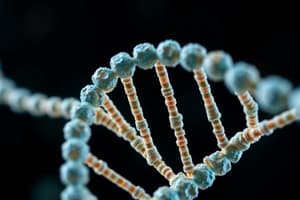Podcast
Questions and Answers
What are the two main steps involved in gene expression?
What are the two main steps involved in gene expression?
- Transcription and Replication
- Translation and Mutation
- Transcription and Translation (correct)
- Replication and Protein Folding
Where does transcription occur in a eukaryotic cell?
Where does transcription occur in a eukaryotic cell?
- Nucleus (correct)
- Cell membrane
- Cytoplasm
- Ribosome
Which enzyme is responsible for transcribing DNA into mRNA?
Which enzyme is responsible for transcribing DNA into mRNA?
- DNA polymerase
- Ribosome
- RNA polymerase (correct)
- DNA ligase
What is the initial step in the translation process of mRNA into amino acids?
What is the initial step in the translation process of mRNA into amino acids?
What does the term 'universal genetic code' refer to?
What does the term 'universal genetic code' refer to?
How can biotechnology contribute to human health?
How can biotechnology contribute to human health?
What best describes genetic engineering?
What best describes genetic engineering?
What is a GMO?
What is a GMO?
What chemical bonds hold the two strands of DNA together?
What chemical bonds hold the two strands of DNA together?
Which nucleotide base pairs with Adenine (A) in DNA?
Which nucleotide base pairs with Adenine (A) in DNA?
What role does DNA polymerase play during DNA replication?
What role does DNA polymerase play during DNA replication?
What is meant by 'expressing' a gene?
What is meant by 'expressing' a gene?
How many genes do humans have roughly?
How many genes do humans have roughly?
What is commonly referred to as 'junk' DNA?
What is commonly referred to as 'junk' DNA?
Which process describes the replication of DNA strands?
Which process describes the replication of DNA strands?
Why is Helicase important during DNA replication?
Why is Helicase important during DNA replication?
Flashcards
DNA Structure
DNA Structure
DNA is a double helix, like a twisted ladder, made of nucleotide monomers.
DNA Replication
DNA Replication
The process of making a copy of DNA. Helicase unwinds DNA, DNA polymerase builds new strands.
Nucleotide Base Pairs
Nucleotide Base Pairs
Adenine (A) with Thymine (T), and Guanine (G) with Cytosine (C).
DNA Replication Enzyme
DNA Replication Enzyme
Signup and view all the flashcards
Gene Expression
Gene Expression
Signup and view all the flashcards
DNA Function
DNA Function
Signup and view all the flashcards
Gene
Gene
Signup and view all the flashcards
Human Genome
Human Genome
Signup and view all the flashcards
Gene Expression Steps
Gene Expression Steps
Signup and view all the flashcards
Transcription
Transcription
Signup and view all the flashcards
Translation
Translation
Signup and view all the flashcards
Genetic Code
Genetic Code
Signup and view all the flashcards
Universal Genetic Code
Universal Genetic Code
Signup and view all the flashcards
Gene Expression & Biotechnology
Gene Expression & Biotechnology
Signup and view all the flashcards
Protein Production w/ Bacteria
Protein Production w/ Bacteria
Signup and view all the flashcards
Study Notes
Lecture 11: DNA, Gene Expression, and Biotechnology
-
DNA Structure & Function:
- DNA is a helical-like structure
- Monomers are nucleotides composed of molecules
- Nucleotide bases: Adenine (A), Thymine (T), Guanine (G), and Cytosine (C)
- Complementary base pairing: A with T, and G with C, holds two strands together
- Hydrogen bonds hold the two DNA strands together
- Complementary bonding between nucleotides
- Adenine (A) always pairs with Thymine (T)
- Guanine (G) always pairs with Cytosine (C)
- DNA's structure enables easy information storage and transmission to offspring.
- DNA replication involves DNA polymerase and helicase enzymes.
- DNA polymerase is a proofreader enzyme during replication
-
Gene Expression:
- Humans have many genes (exact number not specified)
- A percentage of human genes code for proteins(not specified)
- Genes are related to proteins
- "Junk" DNA's function is not completely understood
- Gene expression relates to cell differentiation because different cells use different genes to produce different proteins
- Gene expression describes gene activation
- Central Dogma: DNA -> RNA -> Protein, describes information flow for gene expression.
- Steps in Gene Expression(Transcription and Translation)
- Transcription: DNA to mRNA
- Starting material: DNA, product: mRNA, location: nucleus.
- Enzyme transcribing gene to mRNA: RNA polymerase.
- Translation: mRNA to protein:
- Starting material: mRNA, product: protein, location: cytoplasm.
- Transcription: DNA to mRNA
- Steps to translate mRNA to amino acids: mRNA, transfer RNA (tRNA), ribosomes use codons. Codons are groups of 3 nucleotide bases. tRNA has anti codons for specific amino acids. Ribosomes align mRNA allowing tRNA to add amino acids to the growing polypeptide chain.
- Practice with Protein Synthesis: Transcribe sample DNA to mRNA and use the genetic code table to find the corresponding amino acids.
-
Biotechnology:
- Genetic code is universal across organisms
- Biotechnology relates to gene expression
- Biotechnology improvements in human health,
- Uses of biotechnology in food, medicine, and research.
- Genetically engineered organisms/methods.
- Bacteria production of proteins
- GMOs (Genetically Modified Organisms) and transgenic animals
Studying That Suits You
Use AI to generate personalized quizzes and flashcards to suit your learning preferences.




